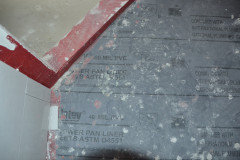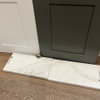What to do when a project goes completely SOUTH
AJCN
4 years ago
last modified: 4 years ago
Featured Answer
Comments (66)
Related Discussions
Hoping to stop a shower disaster before it starts - help!
Comments (40)Tell the GC to tell them to treat your home as a work site and to use professional language. Because the work site is your home, many bubbas use overly familiar, and sexist language with the woman of the house. You should not have to confront the subcontractors yourself. Tell the GC that they need to talk to you the same as if you were standing in a regular office building. If they still do it, you can nip it in the bud on-site, and then ask the GC to have another talk with them. "don't you worry little lady, your pretty princess bathroom is going to be all sparkly when I'm done!" I'm sure you're right about that, but will it leak and ruin my walls and floor? What waterproofing method and materials are you using? That's the most important thing here, don't you think? Here's one I heard from someone else on this forum: "I know you. You always have to have it exactly how you have to have it." I have no idea how I'd respond to that one! "You're too hard to please." So, if it's is too hard for you to build a waterproof shower, what are you planning to build here, a non-waterproof shower? Sometimes conractors talk like this just because it's just a habit, and the person just doesn't know any better. But other times it is a "soft" form of bullying and intimidation; a way of "putting you in your place" so that you will shut up and stop asking questions. The quit-contractor on my botched bathroom job said things like this and it was definately a form of intimidation and buillying because they knew they were not waterproofing the shower correctly and they were angry that I had asked questions about it. I was usually only home for a few minutes in the morning, to greet them, ask any questions and then I would leave for the majority of the day. So I only had a couple of minutes each day to talk to them. It's not like I was breathing down their necks asking questions all day long. I was almost always gone. Each and every response coming out of the contractor's mouth was meant to bully and intimidate. This type of bullying is pretty effective most of the time, so there is a lot of incentive for them to use this tactic. My new contactor was totally professional and never, ever, not even once, said anything different to me than he would have to my husband. He was also very very professional and pleasant with the other members of his team. It was the first time ever that I had that experience. The professionalism not only made the whole atmosphere much more pleasant, it enabled great communication between us which helped the whole project go smoothly. Different situtations call for different approaches. If I had a great pro doing awesome work and he had been professional all along, and then one day let slip a remark, I'd probably just let it slide because things are not black and white in this world. On the other hand, if it's happening all the time and is the go-to response every time you ask a question, then the contractor's appoach is starting to affect the communication between contractor and customer. Anything that diminishes the communication is bound to have a negative affect on the overall project. If the customer is feeling intimidated, or made to feel stupid for asking questions, she will probably ask fewer questions, which may lead to misunderstandings and overall negative affect on the work. If the remarks are intended to shut you down, then the contractor will be happy his tactics worked. Think about your regular job. If you had a new team member join in on a project, and everytime they asked you a question about the project, you shut them down with a remark which is meant to make them feel diminished or stupid, would that team member be learining anything? Would the communication among team members be improved? The project would suffer. It's the same thing no matter if you are at an industrial plant, and accounting office, or in your home....See Moremarble bathroom floor problem please HELP
Comments (27)You need documentation no matter what comes next. You need all your in-progress photos, all texts and emails between you and contractor, the contract, the texts and emails from the tile people, printed out manufacturer’s instructions for the waterproofing materials he used such as wall boards and pan liner, texts and emails from the local rep for the manufacture (if you contacted them), etc, etc. Buy the TCNA handbook and read the shower chapters. Ask for a meeting. In meeting explain what your concerns are and cite all the things that he did wrong, with in-progress photos and cross-referencing all the violations to the standards, codes and instructions. Ask what his plan is for re-building the shower. If he refuses, ask him does that mean he’s quitting the project? If he says yes, that means he has quit, you did not fire him, document/confirm that in an email. If he says no he’s not quitting, then tell him remedying this situation is part of the project, so ask him which day he’s coming over to demo and re-build it. He may quit at that point. If he does try to re-built it, if/after that fix fails, you can fire him. Then send a demand letter certified return receipt asking for full refund plus the cost that you will have to pay to hire a new tile professional to demo and re-build (use local averages or get actual bids). Cite all the violations like you did in the meeting with the references. We had to do all this stuff when our GC quit rather than fix the issues. It’s a PITA but we got double our money back. Read my “Project Goes South” post, you might find some helpful info in there. Now, if you don’t have any of the documentation I listed above, don’t have a contract, etc, etc, I don’t know what leverage you have. You can still have the meeting and send the demand letter, but if it goes to court documentation is your friend and you want max documentation. Hopefully you can dig up some photos of the waterproofing process involving both the floor and the walls. If you don’t have much, add this to your meeting: ask the contractor to simply explain each step (like he’s teaching you) he used to build your shower, starting with framing. Then write down every word he says, asking him to slow down or repeat if needed. Don’t correct or challenge anything he says; let him explain his process. That can substitute a little bit for your lack of other documentation. Then you can cross reference any wrong info he told you to the codes, standards and manufacturer’s instructions, and proceed from there with demand letter. If he refuses your demand letter, which he will, you can decide about suing him. In my state justice court (small claims) is non-binding. We didn’t sue our GC, but he sued us saying we fired wrongfully him. We responded with counter-suit in District Court and asked that the lower case get rolled up to that level because of the $ amount and we wanted a binding decision. It’s a pain and I hope we never have to talk to a judge again, but we had to respond to quit-GCs suit and go through the process. Best of luck to you....See MoreAm I being Hyper-Critical of this Tile Work...?
Comments (34)There are a lot of good tile contractors out there. Just not in each and every location. There are ways of finding them that go beyond personal recommendations from other homeowners who may not really be able to judge if they received an actual quality job on their project. Most of your better quality tile contractors will belong to an industry association, and/or have certification from industry organizations. The time away from income producing jobs to get that education and certifications is costly. It raises the rates for those weeks that they are available for work. Being industry recognized also allows labor rates to be raised. The overhead costs of running a legitimate small business cannot be emphasized enough. Licensing, insurance, software, memberships, that all adds up. Great contractors are expensive. Poor contractors are even more expensive. No one wants to do a job twice. Or three times. Usually, someone who has had a disaster goes straight for the cream of the crop to fix it. Some unfortunately, due to costs, end up making the same mistake and hiring based on cost rather than demonstrable knowledge and ability. This link gets shared a lot. Because it’s things that homeowners don’t know to talk about. The answers determine the difference between a Tile Professional, and a “tile guy”. https://www.ceramictilefoundation.org/homeowners-guide-to-hiring-qualified-tile-installer...See MoreOn a scale of 1:10 how bad is this?
Comments (21)"It should not matter why the workman did a bad job unless it was due to something you specified or supplied." Res 3D, the reason I wrote what I did was because it can matter. If work is done poorly, the first step in remediation is to give the original installer a chance to make it right. Knowing why they did "bad work" can help with the conversation to decide if they get another shot at it. If a homeowner simply fires a worker and does not pay per the contract, then has someone else come in to redo the work, the homeowner may open themselves up to a court action or a lien on their property from the original worker, and may have to pay twice. Or at least have to suffer the pains of going through some sort of arbitration process. If the homeowner and installer instead come to a mutual agreement that they should part ways and put the separation agreement in writing? Much safer alternative for the homeowner....See MoreAJCN
4 years agolast modified: 4 years agoJoseph Corlett, LLC
4 years agoAJCN
4 years agoAJCN
4 years agoAJCN
4 years agoAJCN
4 years agolast modified: 4 years agoAJCN
4 years agoAJCN
4 years agolast modified: 4 years agoAJCN
4 years agoHelen
4 years agotartanmeup
4 years agojmm1837
4 years agoHelen
4 years agoAJCN
4 years agojmm1837
4 years agodsnine
4 years agoAJCN
4 years agotartanmeup
4 years agoAJCN
4 years agoAJCN
4 years agoAJCN
4 years agoWendy Bird
4 years agoK R
4 years agoAJCN
4 years agoAJCN
4 years agoAJCN
4 years agoAJCN
4 years agoM
4 years agoAJCN
4 years agoAvanti Tile & Stone / Stonetech
4 years agoraee_gw zone 5b-6a Ohio
4 years agoAJCN
4 years agolast modified: 4 years ago
Related Stories

DECORATING PROJECTSDIY Project: Wallpaper Goes Mobile
Paper Plywood Panels for a Great Look That Can Move When You Do
Full Story
HOUZZ PRODUCT NEWSHow to Help a Client Visualize a Project When You Can’t Meet
Inspiration photos, mood boards, 3D models, sample boxes and even drones help bridge the gap in a remote client meeting
Full Story
CONTRACTOR TIPSBuilding Permits: When a Permit Is Required and When It's Not
In this article, the first in a series exploring permit processes and requirements, learn why and when you might need one
Full Story
DIY PROJECTSLace Goes Modern in an Upholsterer's DIY Pendant Lights
Bring romance to a room with delicate pendant lights you can make yourself
Full Story
SHELTERING AT HOMEHow to Keep Your Home Project on Track
Take care of the prep work now so you can move quickly on your remodel when restrictions ease
Full Story
BEDROOMSA Little Design Help Goes a Long Way in This Bedroom
A Kentucky couple bring in a designer to polish up a bedroom redesign project they had started
Full Story
WORKING WITH PROSYour Guide to a Smooth-Running Construction Project
Find out how to save time, money and your sanity when building new or remodeling
Full Story
KITCHEN DESIGN7 Tricky Questions to Ask When Planning Your New Kitchen
Addressing these details will ensure a smoother project with personalized style
Full Story
MOST POPULARFirst Things First: How to Prioritize Home Projects
What to do when you’re contemplating home improvements after a move and you don't know where to begin
Full Story
PET PLACESPet’s Place: No Workday Is Complete Without Abby
An interior designer makes her dog a part of everyday life at her Charleston, South Carolina, company
Full Story











Cabot & Rowe